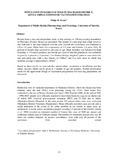| dc.contributor.author | Kitala, Philip M | |
| dc.date.accessioned | 2013-08-02T11:40:33Z | |
| dc.date.available | 2013-08-02T11:40:33Z | |
| dc.date.issued | 1995 | |
| dc.identifier.citation | Philip M. Kitala (1995). Population dynamics of dogs in Machakos District, Kenya: implications for vaccination strategy | en |
| dc.identifier.uri | http://www.google.co.ke/url?sa=t&rct=j&q=&esrc=s&source=web&cd=4&ved=0CD4QFjAD&url=http%3A%2F%2Fsearg.info%2Ffichiers%2Farticles%2F1995096104L.PDF&ei=Z5n7Uf3XJczdPZisgegK&usg=AFQjCNHYTHMwURlZYJm2XfrgoLAC1tI3oQ&bvm=bv.50165853,d.ZWU | |
| dc.identifier.uri | http://hdl.handle.net/11295/54019 | |
| dc.description.abstract | Results from a one year longitudinal study of dog ecology on 150 dog-owning households
in Machakos District, Kenya are presented. The sample of study dogs had a high turnover
rate with half of the dogs replaced over the year. Overall life expectancy was estimated at
2.8 to 2.9 years. Males had a live expectancy of 3.5 years and females 2.4 years. Only 39
percent of female dogs survived to one year of age. High mortality was balanced by high
fecundity (1.3 females produced per female per year) so that the population was estimated
to grow by 9 percent (± 5 percent). Two distinct density (dog/km2) patterns were observed,
one peri-urban area with a dog density of 110/km2 and five rural areas in which dog
densities average 2 approximately 10/km2 .
Based on these results we conclude that annual rabies vaccination is insufficient and that
rabies vaccines which can be given at 3 months of age are required. Further information
needs for the appropriate design of vaccination programmes for rural dog populations are
discussed. | en |
| dc.language.iso | en | en |
| dc.title | Population dynamics of dogs in Machakos District, Kenya: implications for vaccination strategy | en |
| dc.type | Presentation | en |

